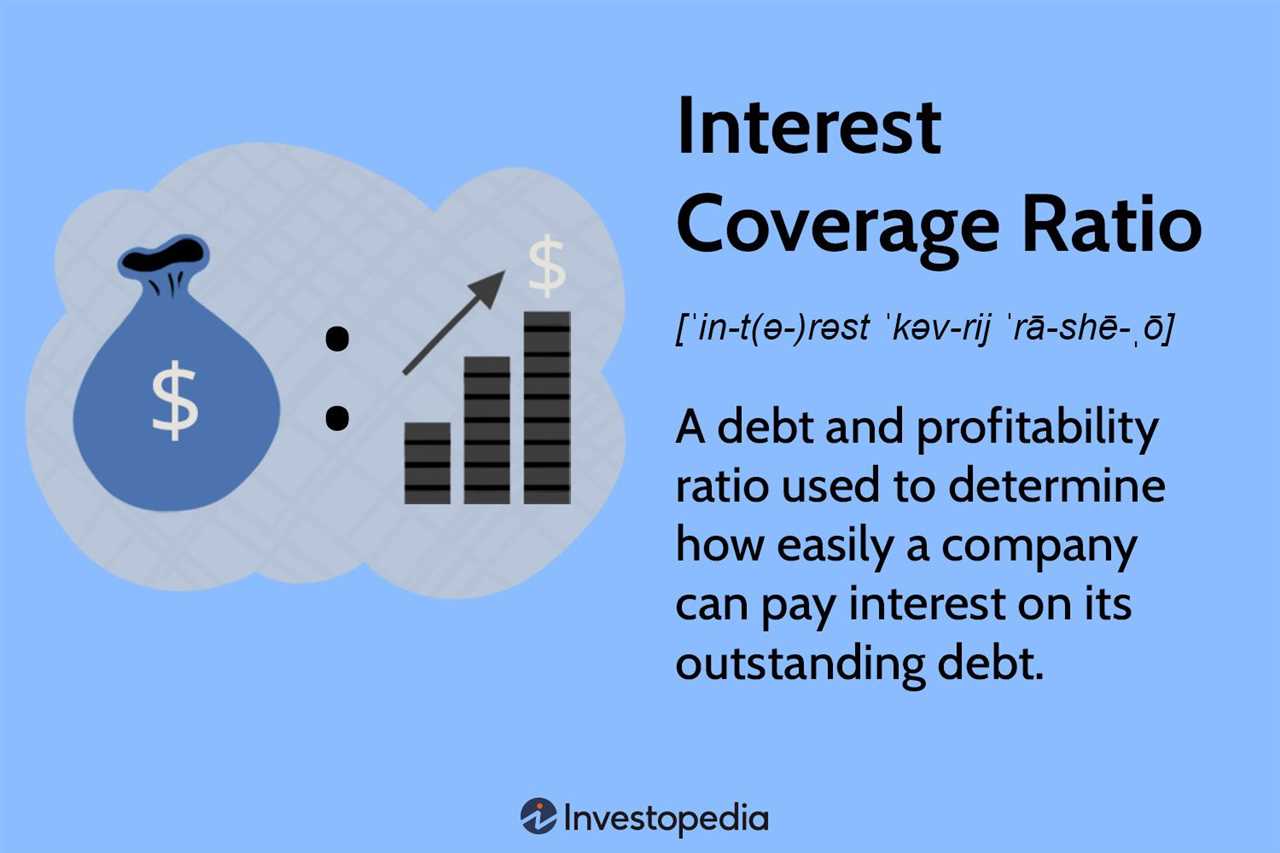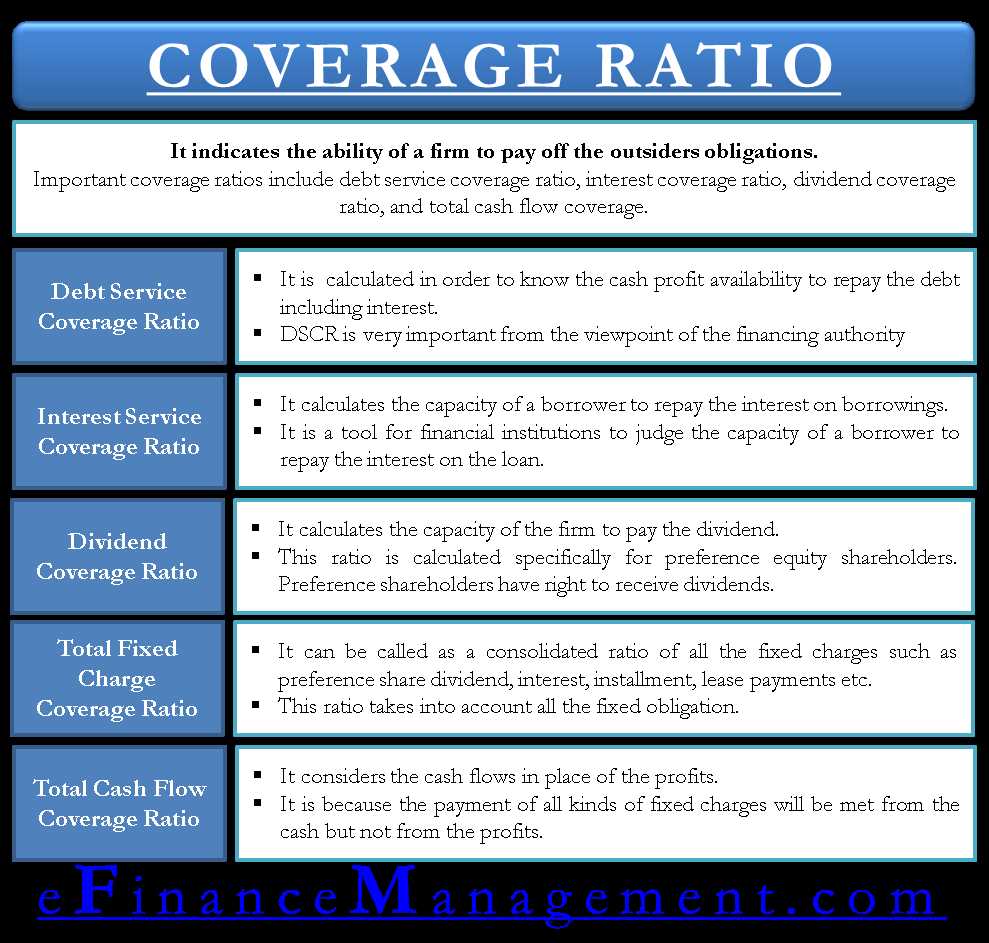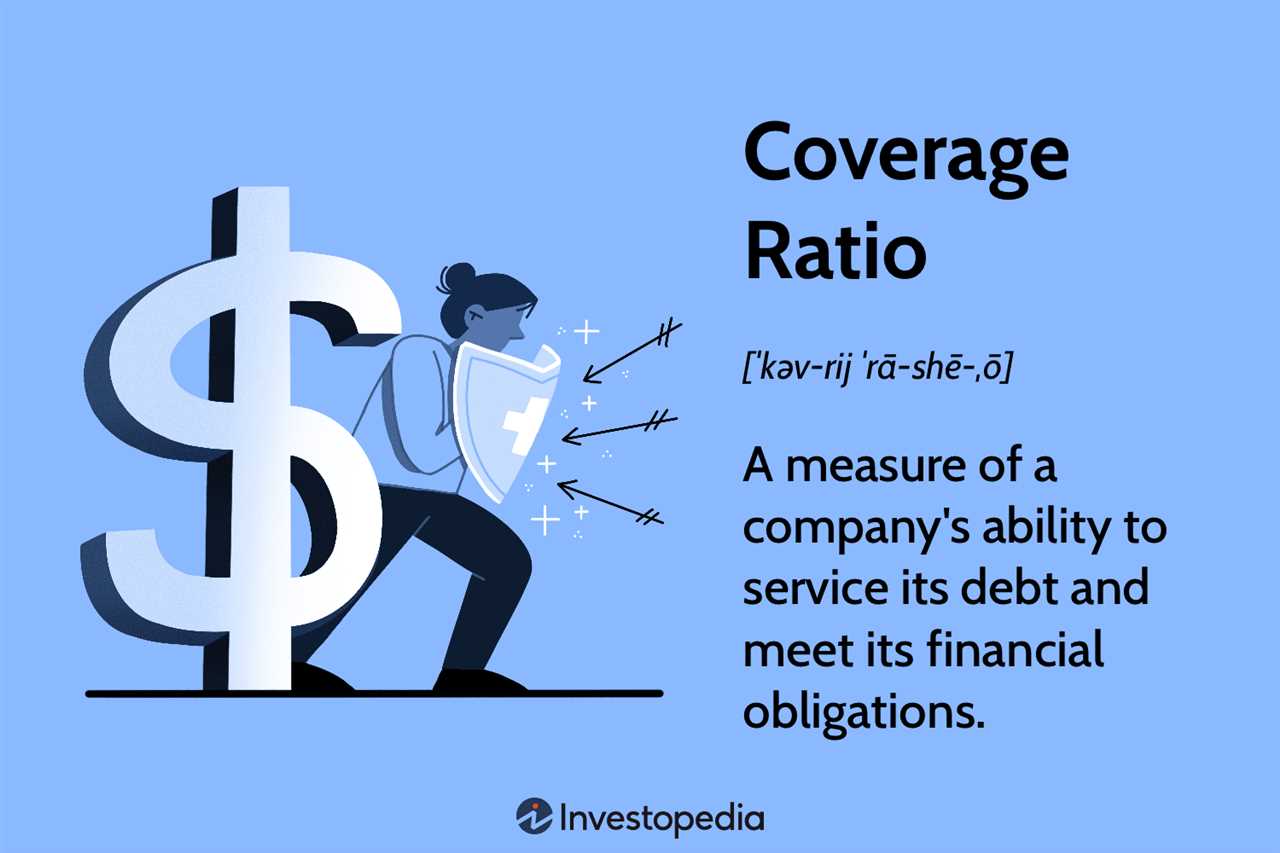Types of Coverage Ratios
Coverage ratios are financial ratios that measure a company’s ability to cover its financial obligations. There are several types of coverage ratios that provide different insights into a company’s financial health and ability to meet its obligations. These ratios are commonly used by investors, creditors, and analysts to assess the risk associated with investing in or lending to a company.
1. Debt Service Coverage Ratio (DSCR)
The debt service coverage ratio (DSCR) is a measure of a company’s ability to cover its debt payments. It is calculated by dividing a company’s net operating income by its total debt service, including principal and interest payments. A DSCR of less than 1 indicates that a company is unable to cover its debt payments, while a ratio of greater than 1 indicates that a company has sufficient income to cover its debt obligations.
2. Interest Coverage Ratio
The interest coverage ratio measures a company’s ability to cover its interest expenses with its operating income. It is calculated by dividing a company’s earnings before interest and taxes (EBIT) by its interest expense. A higher ratio indicates that a company has a greater ability to cover its interest payments, while a lower ratio may indicate a higher risk of default.
3. Asset Coverage Ratio
The asset coverage ratio measures a company’s ability to cover its debt obligations with its assets. It is calculated by dividing a company’s total assets by its total liabilities. A higher ratio indicates that a company has a greater ability to cover its debt obligations with its assets, while a lower ratio may indicate a higher risk of default.
4. Cash Flow Coverage Ratio

The cash flow coverage ratio measures a company’s ability to cover its debt payments with its cash flow. It is calculated by dividing a company’s cash flow from operations by its total debt payments. A higher ratio indicates that a company has a greater ability to cover its debt payments with its cash flow, while a lower ratio may indicate a higher risk of default.
5. Fixed Charge Coverage Ratio

The fixed charge coverage ratio measures a company’s ability to cover its fixed charges, including interest expenses and lease payments, with its operating income. It is calculated by dividing a company’s earnings before interest, taxes, depreciation, and amortization (EBITDA) by its fixed charges. A higher ratio indicates that a company has a greater ability to cover its fixed charges, while a lower ratio may indicate a higher risk of default.
These are just a few examples of coverage ratios that are commonly used in financial analysis. Each ratio provides a different perspective on a company’s ability to meet its financial obligations, and it is important to consider multiple ratios when assessing a company’s financial health.
What is a Coverage Ratio?
A coverage ratio is a financial metric used to evaluate a company’s ability to meet its financial obligations. It measures the company’s ability to cover its interest payments and other fixed costs with its operating income or cash flow. Coverage ratios are important indicators of a company’s financial health and its ability to manage its debt obligations.
Importance of Coverage Ratios
Coverage ratios are important for both investors and lenders. For investors, coverage ratios provide insights into a company’s ability to generate enough cash flow to cover its debt payments and other fixed costs. This information helps investors assess the risk associated with investing in a particular company.
For lenders, coverage ratios help determine the creditworthiness of a company and its ability to repay its loans. Lenders use coverage ratios to assess the risk of default and to set appropriate interest rates for loans.
Types of Coverage Ratios
There are several types of coverage ratios that measure different aspects of a company’s ability to cover its financial obligations. Some common types of coverage ratios include:
- Interest Coverage Ratio: This ratio measures a company’s ability to cover its interest payments with its operating income. It is calculated by dividing the company’s earnings before interest and taxes (EBIT) by its interest expenses.
- Debt Service Coverage Ratio: This ratio measures a company’s ability to cover its debt payments with its operating income. It is calculated by dividing the company’s net operating income by its total debt service.
- Fixed Charge Coverage Ratio: This ratio measures a company’s ability to cover its fixed costs, including interest expenses and lease payments, with its operating income. It is calculated by dividing the company’s earnings before interest, taxes, depreciation, and amortization (EBITDA) by its fixed charges.
Conclusion
Types of Coverage Ratios
Coverage ratios are financial metrics that measure a company’s ability to meet its financial obligations. There are several types of coverage ratios that provide insight into different aspects of a company’s financial health. Here are some common types of coverage ratios:
1. Debt Service Coverage Ratio (DSCR): This ratio measures a company’s ability to cover its debt payments. It is calculated by dividing the company’s operating income by its total debt service, including interest and principal payments. A higher DSCR indicates a better ability to meet debt obligations.
2. Interest Coverage Ratio: This ratio measures a company’s ability to cover its interest expenses. It is calculated by dividing the company’s operating income by its interest expenses. A higher interest coverage ratio indicates a better ability to meet interest payments.
3. Fixed Charge Coverage Ratio: This ratio measures a company’s ability to cover its fixed expenses, including interest, lease payments, and other fixed costs. It is calculated by dividing the company’s operating income by its fixed charges. A higher fixed charge coverage ratio indicates a better ability to meet fixed expenses.
4. Cash Flow Coverage Ratio: This ratio measures a company’s ability to cover its debt payments using its cash flow. It is calculated by dividing the company’s cash flow from operations by its total debt service. A higher cash flow coverage ratio indicates a better ability to meet debt obligations using cash flow.
5. Asset Coverage Ratio: This ratio measures a company’s ability to cover its debt obligations using its assets. It is calculated by dividing the company’s total assets by its total liabilities. A higher asset coverage ratio indicates a better ability to meet debt obligations using assets.
These are just a few examples of the types of coverage ratios that can be used to assess a company’s financial health. Each ratio provides a different perspective on a company’s ability to meet its financial obligations, and they can be used together to get a comprehensive view of a company’s financial position.
Formulas for Calculating Coverage Ratios
A coverage ratio is a financial ratio that measures a company’s ability to cover its financial obligations. There are several types of coverage ratios, each calculated using different formulas. These ratios provide insight into a company’s financial health and its ability to meet its debt and interest payments.
Here are some common formulas for calculating coverage ratios:
1. Debt Service Coverage Ratio (DSCR)
The Debt Service Coverage Ratio measures a company’s ability to cover its debt obligations. It is calculated by dividing the company’s net operating income by its total debt service.
DSCR = Net Operating Income / Total Debt Service
2. Interest Coverage Ratio
The Interest Coverage Ratio measures a company’s ability to cover its interest expenses. It is calculated by dividing the company’s earnings before interest and taxes (EBIT) by its interest expenses.
Interest Coverage Ratio = EBIT / Interest Expenses
3. Fixed Charge Coverage Ratio
The Fixed Charge Coverage Ratio measures a company’s ability to cover its fixed charges, which include interest expenses and lease payments. It is calculated by dividing the company’s earnings before interest, taxes, depreciation, and amortization (EBITDA) by its fixed charges.
Fixed Charge Coverage Ratio = EBITDA / Fixed Charges
4. Asset Coverage Ratio
The Asset Coverage Ratio measures a company’s ability to cover its debt obligations with its assets. It is calculated by dividing the company’s total assets by its total liabilities.
Asset Coverage Ratio = Total Assets / Total Liabilities
5. Cash Flow Coverage Ratio
The Cash Flow Coverage Ratio measures a company’s ability to cover its debt obligations with its cash flow. It is calculated by dividing the company’s cash flow from operations by its total debt.
Cash Flow Coverage Ratio = Cash Flow from Operations / Total Debt
These formulas provide valuable insights into a company’s financial health and its ability to meet its financial obligations. By analyzing a company’s coverage ratios, investors and lenders can assess the company’s risk profile and make informed decisions.
Examples of Coverage Ratios in Practice

Coverage ratios are important financial metrics that provide insight into a company’s ability to meet its financial obligations. Here are some examples of coverage ratios commonly used in practice:
- Debt Service Coverage Ratio (DSCR): This ratio measures a company’s ability to cover its debt payments. It is calculated by dividing the company’s net operating income by its total debt service. For example, if a company has a net operating income of $500,000 and a total debt service of $400,000, the DSCR would be 1.25 ($500,000 / $400,000).
- Interest Coverage Ratio: This ratio measures a company’s ability to cover its interest expenses. It is calculated by dividing the company’s earnings before interest and taxes (EBIT) by its interest expenses. For example, if a company has an EBIT of $1,000,000 and interest expenses of $200,000, the interest coverage ratio would be 5 ($1,000,000 / $200,000).
- Fixed Charge Coverage Ratio: This ratio measures a company’s ability to cover its fixed charges, which include interest expenses, lease payments, and other fixed obligations. It is calculated by dividing the company’s earnings before interest, taxes, depreciation, and amortization (EBITDA) by its fixed charges. For example, if a company has an EBITDA of $2,000,000 and fixed charges of $1,500,000, the fixed charge coverage ratio would be 1.33 ($2,000,000 / $1,500,000).
- Asset Coverage Ratio: This ratio measures a company’s ability to cover its debt obligations with its assets. It is calculated by dividing the company’s total assets by its total liabilities. For example, if a company has total assets of $10,000,000 and total liabilities of $5,000,000, the asset coverage ratio would be 2 ($10,000,000 / $5,000,000).
These examples demonstrate how coverage ratios can be used to assess a company’s financial health and its ability to meet its financial obligations. By analyzing these ratios, investors and creditors can make informed decisions about the company’s creditworthiness and risk profile.

Emily Bibb simplifies finance through bestselling books and articles, bridging complex concepts for everyday understanding. Engaging audiences via social media, she shares insights for financial success. Active in seminars and philanthropy, Bibb aims to create a more financially informed society, driven by her passion for empowering others.
